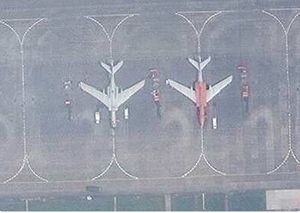China’s People’s Liberation Army Navy Air Force (PLANAF) has acquired Xian-H-6J anti-ship cruise missile-carrying bombers, according to satellite imagery taken on September 7. An analysis of the satellite images shows that the first four H-6J bombers — assumed to be the naval variant of the upgraded H-6K — were on the ground at the PLANAF air base at Guiping-Mengshu in Guangxi in early September.
“The aircraft at Guiping-Mengshu are assessed to be a variant of the H-6K, which has been in service with the People’s Liberation Army Air Force (PLAAF) since about 2011,” IHS Jane’s reports on October 11 without elaborating on the exact H-6 variant.
The H-6Js are presumably replacing H-6G maritime striker bombers, which first entered service with the PLANAF in the early 1990s. The PLA South Sea Fleet currently operates an H-6G regiment consisting of approximately 14-18 aircraft. In comparison to the older variant, the H-6J is thought to be able to carry about three times the number of anti-ship missiles, and at 3,500 kilometers boasts an increased combat radius of around 50 percent.
With the presumed extended combat range, the new PLANAF bombers, likely part of the 23rd Regiment, 8th Naval Aviation Division assigned to the PLA Southern Theater Command, would be capable of conducting sorties and patrols over nearly the entirety of the South China Sea with two mid-air refuels. (This data is derived from publicly available information on the H-6K.)
The upgrade to the H-6J variant entailed fitting the aircraft with completely new airframes, lighter weight composites, new fuel efficient D-30-KP2 turbofans, advanced avionics, and a full glass cockpit. The bomber also has been fitted with a new long-range surface search radar and an electro-optical targeting pod for target acquisition. The H-6J is primarily an anti-surface warfare platform. It can carry up to seven YJ-12 supersonic anti-ship cruise missiles (ASCM) — six on wing pylons plus one in the bomb bay.
According to the Missile Defense Advocacy group, the YJ-12 ASCM has a range of 400 kilometers, depending on launch altitude, and can reach speeds of up to Mach 3. Fitted with a 200 kilogram high-explosive warhead, the YJ-12 is capable of performing air-borne evasive maneuvers before striking its target. It is thought to be one of the most effective ASCMs in China’s current inventory.
“Crucially, at 400 kilometers, Chinese attack aircraft will be able to launch the YJ-12 beyond the engagement range of the Navy’s Aegis Combat System and the SM-2 surface-to-air missiles that protect U.S. aircraft carrier strike groups. (…) The YJ-12s would employ a variety of sensor types to find their targets and execute dramatic cork-screw turns to evade final defenses,” I quoted an analysis back in 2015 in an article for The Diplomat.
It is unclear whether the PLANAF currently operates additional H-6J bombers besides the four identified on the September 7 satellite imagery. However, this is more than likely. It is fair to assume that the PLANAF intends to stand up a full regiment of H-6Js in the future. Next to the PLANAF’s burgeoning H-6J force, the PLAAF’s H-6K fleet consists of around 40 aircraft. H-6Ks and H-6Gs have noticeably stepped up combat patrols in the South and East China Seas, including the strategically Miyako Strait, in recent years.

































